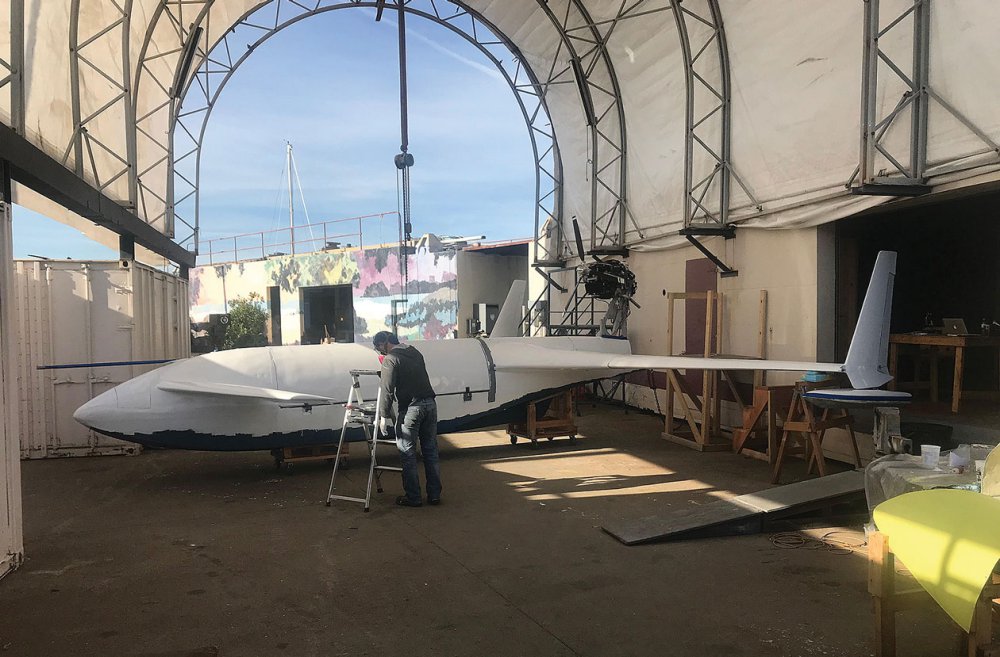Two years after World War II, billionaire Howard Hughes personally piloted his “Spruce Goose” troop transport aircraft on the first and only flight of the largest seaplane ever built. It lasted barely a minute. Now, more than 70 years later, a U.S. startup is testing a new seaplane concept—one that could evolve into huge cargo drones that fly 109 metric tons of freight across the Pacific, touch down autonomously over water, and unload at ports around the world.
The startup Natilus was founded in 2014 with a dream of building large cargo drones to deliver international freight for about half the price of piloted aircraft, and much faster than ships. In December, Natilus planned to test the water-taxiing capabilities of a small prototype drone with a 9-meter wingspan in San Francisco Bay. Waterborne testing, done under the careful watch of the Federal Aviation Administration, sets the stage for flight tests in 2018.
“The first flight will follow the traditional general aviation flight-testing approach, which includes a water takeoff and a climb out to about 200 feet, followed by a cruise, descent, and landing,” says Aleksey Matyushev, CEO and cofounder of Natilus.
These early remote-controlled flight tests could lead to semiautonomous and then fully autonomous flights in which the drone autopilot navigates over a route of waypoints set by a human controller. By removing human pilots, Natilus wants to create a streamlined aircraft with just a single engine and more room for jet fuel or cargo. “So the drone is cheaper to buy, cheaper to operate because you burn less fuel, and cheaper to maintain,” says Francois Chopard, CEO and founder of Starburst Ventures, a company that helps aerospace startups raise seed funding.
Natilus hopes to sell its drones to delivery and logistics companies such as Atlas Air (an Amazon partner), UPS, and DHL in a bid to disrupt the US $15.5 trillion global freight market. The sweet spot in terms of freight could include pricey goods that consumers want quickly, Chopard explains.
Seaplane drones could avoid many of the safety and air traffic control concerns of drones flying over land, says Sanjiv Singh, a robotics researcher at Carnegie Mellon University and CEO of Near Earth Autonomy, a startup focused on intelligent flight systems. “If I have to ditch my containers over the ocean, it’s not the worst thing in the world, because people don’t die and everything is insured,” Singh says.
Before tackling trans-Pacific routes, Natilus first plans to build and sell a small drone by 2020 that can carry nearly 2 metric tons of cargo and operate between regional airports. Such drones could allow companies to open new air shipping routes between cities with low volumes of freight.
Similar cargo drones the size of aircraft have yet to take off in a serious way around the world. The U.S. Marine Corps previously tested a K-Max helicopter modified to become a drone capable of delivering several tons of supplies to troops in Afghanistan. More recently, researchers at the Chinese Academy of Sciences transformed a light aircraft into an experimental AT200 drone that can carry more than 1.5 metric tons of cargo.
Singh and other experts are uncertain whether huge cargo drones can compete with piloted cargo aircraft on cost. “Unmanned cargo drones have an efficiency advantage when they are small,” says Hans Heerkens, chairman of the Platform for Unmanned Cargo Aircraft, an international organization investigating the technology’s possibilities. “I don’t see so much of the efficiency advantage when they are large.”
Still, Heerkens points to a potential market for cargo drones in servicing midsize cities in regions such as China and Africa that lack major airport infrastructure but want to ship goods to international markets. Whether flying over land or sea, Natilus drones could change the way goods are shipped around the world—if they can pass their flight tests.
Source: IEEE

